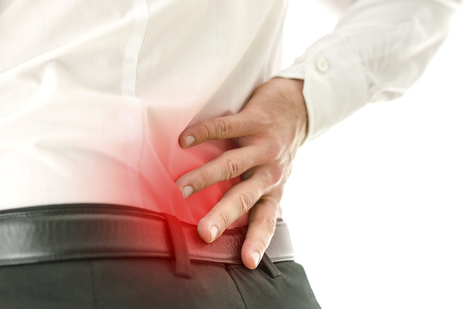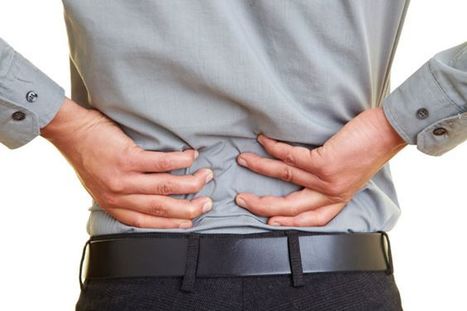 Your new post is loading...
 Your new post is loading...
The irritating pain that accompanies tight muscles along with limited mobility and the numbness that extends down your buttocks and legs are the all too familiar symptoms associated with low back pain relating to conditions of the lumbar spine. But, when your lumbar back pain points to the sacroiliac joint instead, what are your treatment options? The function of the sacroiliac joint is to support the movements of the lower extremities. With overuse or underuse, the local muscles surrounding the joint may become inflamed or tight, adding pressure and stress that will often lead to sacroiliac joint dysfunction, the possible true cause for your low back pain.
Your low back pain could be caused by many reasons, characterized by the familiar symptoms of sciatica, but an additional pain, numbness, or tingling in both of your legs could be indicating another common condition associated with low back pain, lumbar spinal stenosis. Lumbar spinal stenosis is a progressive spinal condition identified by degenerative changes in the spine that lead to a narrowing of the spinal canal. Through time, the narrower spinal canal begins to pinch the spinal nerve roots causing the well-known low back pain.
Chiropractic care focuses on re-establishing the natural healing of the body through manual adjustments and manipulation of the spine. A chiropractor diagnoses and treats neuromuscular disorders by restoring a healthy functionality between the spine and the nervous system, together with educating on the proper stretches, exercises, and a balanced nutrition to promote further healing. Chiropractic treatment restores normal spinal mobility which in turn alleviates the irritation of the spinal nerve that causes pain and affects the function of the other systems in the body. A chiropractor will offer relief to many conditions and disorders.
The psoas muscles are a part of the iliopsoas muscle group. This important set of muscles works together with the other muscles of the hip to flex and extend the hip joints and thighs. The psoas muscles also work in conjunction with the spinal muscles to support the lumbar spine. If the psoas is not healthy or strong enough, you will start noticing other problems surge throughout your body. For many athletes, especially runners, the psoas muscles are constantly being overworked with repetitive activity and movements that eventually can lead to stress and tension of the muscles. As a result, the psoas muscles can become tightened and limit the range of movement in the hip sockets also adding strain on the lumbar spine and knees.
Neck pain is one of the most common types of pain experienced by the general public. Many types of conditions and injuries can cause neck pain, such as arthritis in the neck or a whiplash injury from an automobile accident. Neck pain can range from milder degrees of irritation and discomfort to a more severe and debilitating degree, but there are also other symptoms associated with cervical spine pain. Besides neck pain, another common symptom associated with cervical spine pain is a decreased neck range of motion. The neck range of motion is the degree to how much an individual can bend, extend, rotate, and laterally bend their head and neck. People with neck pain also suffer from stiffness, tight muscles in the area, and aching or burning, which is the leading cause for the limited mobility of the neck.
|
Spondylolisthesis is a condition of the lower back that develops when a single vertebra in the lumbar spine shifts forward over the vertebrae below it, misaligning the natural structure of the spine. The most common cause for this condition is degeneration in the spine. Degeneration begins around the age of 50 and can lead to many issues if left untreated but starting out early with the appropriate exercises will benefit your symptoms associated with spondylolisthesis. Physical therapy is one of the non-surgical ways to treat spondylolisthesis. After completing treatment, following up with a proper routine of stabilization exercises together with flexion and stretching will strengthen the back muscles, restoring back your stability to better support the spine and help you deal with the condition and its symptoms.
El Paso’s chiropractor, Dr. Alex Jimenez discusses the causes of sciatic nerve pain and its symptoms. Sciatica, refers to a group of symptoms instead of a single condition. Sciatic pain most commonly affects the lower back, hip, buttocks, and outer side of the leg. The greater majority of the population has experienced some form of low back pain in their lifetime and the causes for their sciatic nerve pain are numerous. Sciatica is characterized by symptoms of sharp pain extending from the lower back down to the leg, tingling sensations and numbness that is caused by compression, irritation, or pressure of the sciatic nerve.
Cervical spondylosis, also referred to as cervical osteoarthritis, is an age related condition where the cervical spine degenerates as a result of wear and tear on the vertebrae and cartilage. Spinal degeneration changes naturally occur with age, usually beginning in people over the age of 55, but every individual ages differently. The natural aspects of aging affect some people more than others, depending on how much the body is overworked. Weakness of the muscles and tingling can also be associated with cervical spondylosis since the degeneration of the spine makes the spaces in between the vertebrae smaller, causing an impingement of the nerves in the cervical area.
Thoracic outlet syndrome (TOS) is a condition where the brachial plexus nerve bundles and the blood vessels, located in the passage between the anterior and middle scalene down to the brachial plexus pass, become entrapped in this area by tightness of the neck and shoulder muscles, compressing the nerves. The impingement of the nerves in a person suffering from this condition can cause a collection of symptoms from numbness and tingling sensations on the extremities, to weakness and most commonly, pain of various degrees during motion of the neck, shoulders, and upper extremities. Discoloration in the area as a result of diminished circulation is also possible.
The piriformis muscle is the largest and most important of the rotator hip muscles found in the body. Located between the middle of the buttocks and the sacrum, the piriformis muscle functions by rotating the leg and foot outward. A major issue among athletes and the general public is that the sciatic nerve runs under or through the piriformis muscle. Overworking or everyday stress on the body can cause the piriformis muscle to tighten, leading to irritation, swelling, and ultimately pinching of the sciatic nerve, known as piriformis syndrome. Once you have piriformis syndrome, you experience pain in the buttocks that travels down the leg of the affected piriformis muscle.
|



 Your new post is loading...
Your new post is loading...

















Low back pain and symptoms of sciatica don't always originate from the lumbar spine. Sacroiliac joint dysfunction occurs when the sacroiliac joing, which functions by supporting the movements of the lower extremeties, become inflamed or tight due to overuse or underuse, causing pain and discomfort.